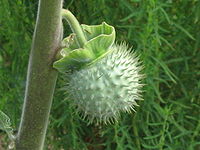DaTura
The word datura comes from the sanskrit dhatr ("thorn apple"); In Sanskrit it is referred as "Kanak" and "Unmatt" in the ancient scriptures of IndianAyurveda by sage Sushrut and Charaka. Record of this name in english dates back to 1662.[3] Nathaniel Hawthorne refers to one type in The Scarlet Letter as apple-Peru. In Mexico, its common name is toloache.
In India it has been referred and attributed to as "Poisonous" and aphrodisiac. In little measures it was used in Ayurveda as a medicine from the ancient times. It is used in rituals and prayers to Lord Shiva.
Cultivation


Datura species are usually planted annually from the seed produced in the spiny pods, but with care, plants can be overwintered. Most species are suited to being planted outside or in containers. As a rule, they need warm, sunny places and soil that will keep their roots dry. When grown outdoors in good locations, the plants tend to reseed themselves and may become invasive. In containers, they should have porous, aerated potting soil with adequate drainage. The plants are susceptible to fungi in the root area, so organic enrichment such as compost and manure should be avoided.[2]
Toxicity[edit source | editbeta]
All Datura plants contain tropane alkaloids such as scopolamine, hyoscyamine, and atropine, primarily in their seeds and flowers. Because of the presence of these substances, Datura has been used for centuries in some cultures as a poison and as a hallucinogen.[2][4] There can be a 5:1 toxin variation across plants, and a given plant's toxicity depends on its age, where it is growing, and the local weather conditions. This variation makes Datura exceptionally hazardous as a drug.
In traditional cultures, a great deal of experience with and detailed knowledge of Datura was critical to minimize harm.[2] Many tragic incidents result from modern recreational users ingesting Datura. For example, in the 1990s and 2000s, the United States media contained stories of adolescents and young adults dying or becoming seriously ill from intentionally ingesting Datura.[5][6] There are also several reports in the medical literature of deaths from D. stramonium and D. ferox intoxication.[7][8][9] Children are especially vulnerable to atropine poisoning, and their prognosis is likely to be fatal.[10][11]
In some parts of Europe and India, Datura has been a popular poison for suicide and murder. From 1950 to 1965, the State Chemical Laboratories in Agra, India, investigated 2,778 deaths caused by ingesting Datura.
The US Centers for Disease Control and Prevention reported accidental poisoning resulting in hospitalization for a family of six who inadvertently ingestedDatura used as an ingredient in stew.[13]
In some places, it is prohibited to buy, sell, or cultivate Datura plants.
Effects of ingestion
Due to the potent combination of anticholinergic substances it contains, Datura intoxication typically produces effects similar to that of an anticholinergicdelirium (as contrasted to hallucination): a complete inability to differentiate reality from fantasy; hyperthermia; tachycardia; bizarre, and possibly violent behavior; and severe mydriasis with resultant painful photophobia that can last several days. Pronounced amnesia is another commonly reported effect.[14]
No other psychoactive substance has received as many severely negative recreational experience reports as has Datura. The overwhelming majority of those who describe their use of Datura find their experiences extremely unpleasant both mentally and physically and often physically dangerous.[14]
Datura is a complex and powerful psychedelic. Getting the dose right is critical. Many have a mystical experience described in terms of a 'rebirth', while others find Datura experiences overly powerful and frightening.[15]
Treatment
Due to their agitated behavior and confused mental state, victims of Datura poisoning are typically hospitalized. Stomach pumping and the administration of activated charcoal can be used to reduce the stomach's absorption of the ingested material. The drug physostigmine is used to reverse the effect of the poisons. Benzodiazepines can be given to curb the patient's agitation, and supportive care with oxygen, hydration, and symptomatic treatment is often provided. Observation of the patient is indicated until the symptoms resolve, usually from 24"36 hours after ingestion of the Datura.[12][16]




































